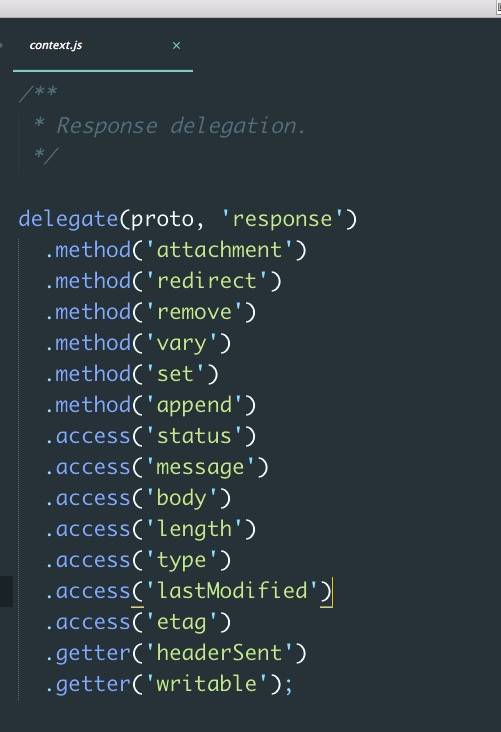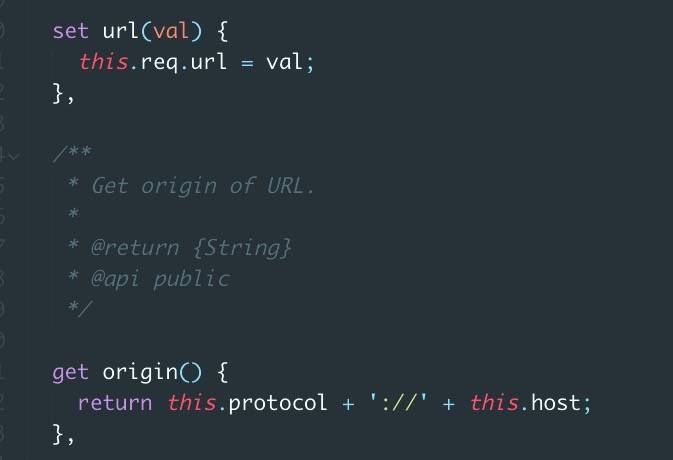本笔记共四篇
Koa 源码阅读笔记(1) – co > Koa 源码阅读笔记(2) – compose > Koa 源码阅读笔记(3) – 服务器の启动与请求处理 > Koa 源码阅读笔记(4) – ctx 对象
起因
前两天终于把自己一直想读的Koa源代码读了一遍。
今天就要来分析 Koa 的ctx对象,也就是在写中间件和处理请求和响应时的那个 this 对象。
而这个this对象,也是和 Express 的重要区别之一。不用再区分req,res(虽然还是得知道),一个this对象就能调用所有方法。
在实际开发中,是非常便利的。
Koa1 和 Koa2 的区别
在这儿则需要谈一谈 Koa1 和 Koa2 调用 this 对象的区别。
Koa1 在调用时,使用的是 this,而 Koa2 则是 ctx。
1 | // Koa1 |
1 | // Koa2 |
使用方式,只是把 this 换成了 ctx。
具体为什么出现 ctx 和 next,之前的文章koa-compose 的分析有写。
ctx 对象的作用
这儿继续以 Koa1 为例,因为看得懂 Koa1 源代码的,看 Koa2 的源码自然也不难。
首先放上关键的源代码:
1 | app.callback = function () { |
在上一篇Koa 源码阅读笔记(3) – 服务器の启动与请求处理中,我们已经分析了 fn 的作用。
而 onFinished 则会在请求完成时调用,剩下的则是调用中间件去处理响应。
同时var ctx = self.createContext(req, res);这一句,不看createContext这个函数,应该也能猜出它的作用。
之后的fn.call(ctx)则说明了中间件中this的来源。
在这儿不得不感叹一句,JavaScript 的 this 真的是太灵活了,配合闭包,call,apply 等,简直拥有无限魔力。
ctx 对象的创建
贴出相关的源代码:
1 | var response = require('./response'); |
虽然看上去有点绕,但是仔细看看,还是不难的。
之前说过,Koa 的源码简洁,一共就 4 个文件。
除了主要的Application.js, 剩下就都是与请求和响应相关的了。
有趣的地方
这儿,因为每次都要创建并调用ctx对象。为了避免影响原有的context,request,response对象。
这儿采用了Object.create()来克隆对象。

context.js
首先就来分析,最开始的 context.js。
context 的实现很简单,但有意思的地方在于 delegate 这个地方。
就如下图所示:
我看了 delegate 这个源代码,功能是把context中相应的方法调用和属性读取,委托至某个对象中。
而不用自己一个一个的写apply,call等。
request, response
关于 request 和 response,我这儿就不详细写了。
在这儿放一张图足以。

实际上,request 和 response 是通过 getter 和 setter,来实现存取不同属性的功能。
另外,通过刚才说的 delegate 方法,则使用 ctx 对象时,便能自动通过 getter 和 setter 获取想要的内容。
结语
这一篇很简单,其实也没啥可以说的。
因为 Koa 除了中间件部分看起来复杂,其它地方还是很简洁明了的。
学习源代码的过程中,也发现了很多优雅的写法,算是开拓了自己的眼界。
从会写到写好,看来还要挺长一段时间的。
前端路漫漫,且行且歌。